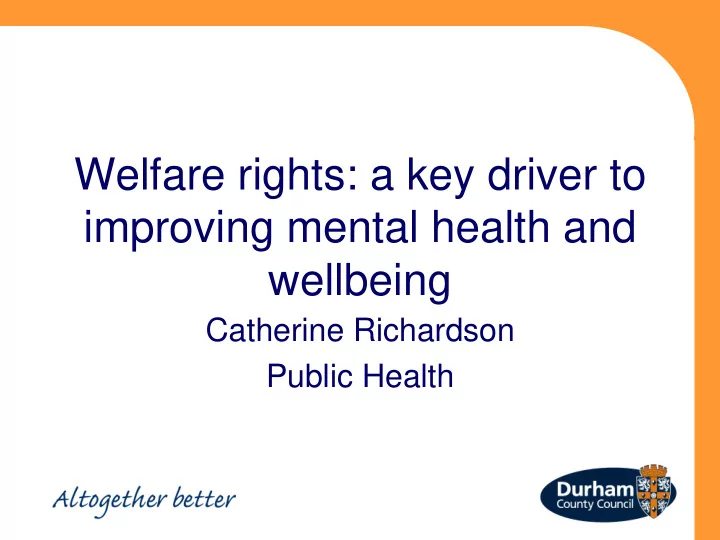

Welfare rights: a key driver to improving mental health and wellbeing Catherine Richardson Public Health
What does Public Mental Health mean in County Durham? • Adopted the Mental Illness and Mental Health: The Two Continua Model Across the Lifespan • This model moves past the concept that mental health is the absence of mental illness and believes that mental health can be enhanced regardless of a diagnosis of mental illness.
The Mental Health/Illness Continuum
Public Mental Health Strategy • Based on local needs • Evidence base • All age • Multi agency partnership • Endorsed by Joint Health & Wellbeing Board • Priority groups
National context
Number of suicides year on year in County Durham
Mosaic- allocation of those taking own life to 7 ‘supergroups’ Mosaic Public Sector Supergroups Your area/file % Comp. % Pen. % Index A Rural and small town inhabitants 17 8.33 42,946 10.65 0.04 78 B Affluent households 3 1.47 23,094 5.73 0.01 26 C Middle income families 19 9.31 60,025 14.89 0.03 63 D Young people starting out 6 2.94 18,017 4.47 0.03 66 E Lower income residents 109 53.43 179,062 44.42 0.06 120 F Elderly occupants 17 8.33 38,263 9.49 0.04 88 G Social housing tenants 33 16.18 41,686 10.34 0.08 156 Total 204 100 403,093 100 0.05 100 Based on postcode; those taking their own life are more likely to be lower income residents and social housing tenants (index value >100)
Mosaic- allocation by ‘group’ Mosaic Public Sector Groups Your area/file % Comp. % Pen. % Index A Residents of isolated rural communities 7 3.43 11,242 2.79 0.06 123 Residents of small and mid-sized towns with strong local B 10 4.90 31,704 7.87 0.03 62 roots Wealthy people living in the most sought after C 0 0.00 4,233 1.05 0.00 0 neighbourhoods Successful professionals living in suburban or semi-rural D 3 1.47 18,861 4.68 0.02 31 homes Middle income families living in moderate suburban E 10 4.90 38,812 9.63 0.03 51 semis Couples with young children in comfortable modern F 9 4.41 21,213 5.26 0.04 84 housing G Young, well-educated city dwellers 2 0.98 6,849 1.70 0.03 58 Couples and young singles in small modern starter H 4 1.96 11,168 2.77 0.04 71 homes Lower income workers in urban terraces in often diverse I 20 9.80 27,274 6.77 0.07 145 areas Owner occupiers in older-style housing in ex-industrial J 23 11.27 46,853 11.62 0.05 97 areas Residents with sufficient incomes in right-to-buy social K 66 32.35 104,935 26.03 0.06 124 housing Active elderly people living in pleasant retirement L 2 0.98 6,268 1.55 0.03 63 locations M Elderly people reliant on state support 15 7.35 31,995 7.94 0.05 93 N Young people renting flats in high density social housing 2 0.98 2,714 0.67 0.07 146 Families in low-rise social housing with high levels of O 31 15.20 38,972 9.67 0.08 157 benefit need Total 204 100 403,093 100 0.05 100
Results; 2005-2012 data • 81% male; age distribution shown below Number of suicides Age
Trends over time… Number of suicides Year
Characteristics of those taking their own life • 62.8% were divorced, separated, single, or widowed • 32.2% lived alone • 30% were unemployed • The most common method was hanging/strangulation
Characteristics of those taking their own life • 58.9% were recorded as having a mental health problem • 39.2% had a history of self-harm • 20% had significant alcohol intake recorded • 13% were drug users • 53% had a history of involvement with Criminal justice system (CJS)
Contact with services • 44% had contact with their GP in the 3 months before death • 37.9% had contact with mental health services in the 12 months before their death, of these; • 82% unemployed • 37% lived alone • 68% single • 57% contact with CJS • 37% noted as having alcohol problem • 18% recorded as drug users
Themes for those where multiple triggers thought to be relevant Theme Number of cases affected Mental health problems 33 Family/relationship 33 breakdown Ill health 12 Bereavement 29 Alcohol 15 Financial problems 29 Drug use 7 Problems at work 3 Police involvement 5
So, overall, most common triggers are; Theme Number affected Percentage Mental Health 74 25.9% Diagnoses Family/relationship 73 25.6% breakdown Bereavement 47 16.5% Financial Problems 34 11.9%
Is the economic crisis going to spell more suicides in County Durham?
What is already available in County Durham ? • Welfare Rights service targeted at those with poor mental health • Bereavement • U Care Share deliver family practical support incl a home visit • Cruse deliver bereavement support • As part of counselling provision; bereavement counselling • Financial support is currently delivered through CAB • A county wide relationship support service is available through ‘Relate’. Couples counselling is offered through IAPT and some volunteer organisations also offer support. • Community support through CREE (sheds project)
Prevention of Mental Ill-Health Reduce the suicide and self-harm rate Cree project – Locally based – The ‘Reason’ and Focus – Champions – Training – Referral/Ongoing Support – Welfare Rights support
Cree project
Thank you • Catherine.richardson@durham.gov.uk
Recommend
More recommend